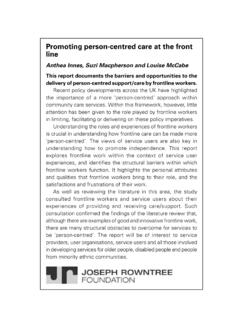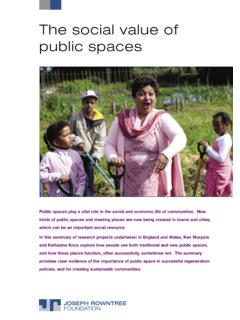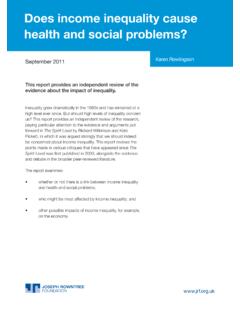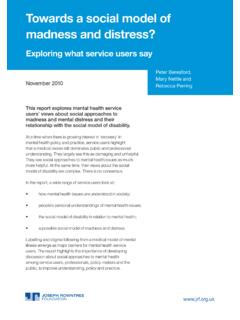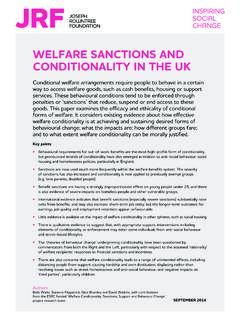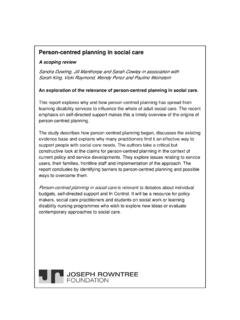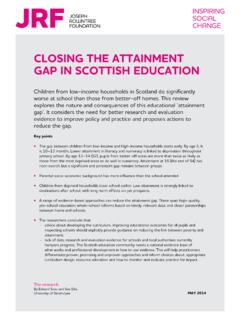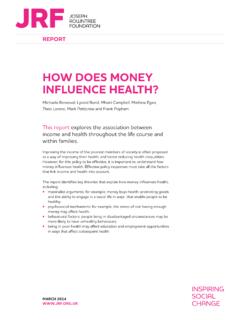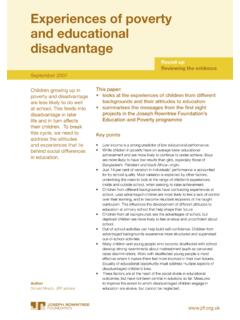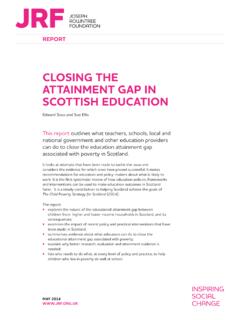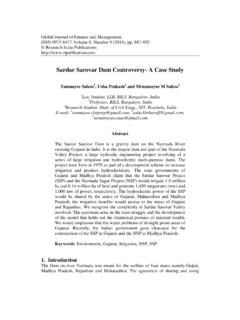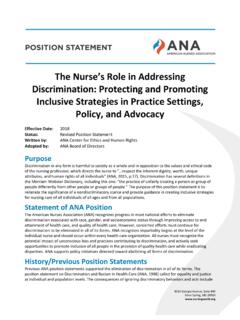Transcription of Resilience and young people leaving care
1 Resilience and young people leaving careOvercoming the oddsMike SteinA literature review exploring the factors affecting young people leaving care asthey make their transition to adulthood and young people leave care they face a variety of challenges. Some meet andovercome these challenges, yet others struggle. This review found a gap in theliterature on Resilience among young people leaving care. It therefore drawsupon research studies completed in the last twenty years which have capturedthe experiences, views and reflections of the young people themselves. Inreviewing the research evidence, the report captures the different stages orcontexts of young peoples journeys: their journeys through care, including an exploration of stability, continuityand attachment, identity, education, leisure and preparation their transitions from care their lives after care the impact of leaving care publication can be provided in alternative formats, suchas large print, Braille, audiotape and on disk.
2 Please contact:Communications Department, Joseph Rowntree Foundation,The Homestead, 40 Water End, York YO30 : 01904 615905. Email: and young people leavingcareOvercoming the oddsMike SteinThe Joseph Rowntree Foundation has supported this project as part of its programme ofresearch and innovative development projects, which it hopes will be of value to policymakers, practitioners and service users. The facts presented and views expressed in thisreport are, however, those of the author and not necessarily those of the Rowntree FoundationThe Homestead40 Water EndYork YO30 6 WPWebsite: Stein is a research professor in the Social Work Research and Development Unit at theUniversity of York. For the past 25 years he has been researching the problems andchallenges faced by young people leaving care. He has published extensively in this field andwas involved in the preparation of the Guidance for the Children ( leaving Care) Act 2000. University of York 2005 First published 2005 by the Joseph Rowntree FoundationAll rights reserved.
3 Reproduction of this report by photocopying or electronic means for non-commercial purposes is permitted. Otherwise, no part of this report may be reproduced,adapted, stored in a retrieval system or transmitted by any means, electronic, mechanical,photocopying, or otherwise without the prior written permission of the Joseph 1 85935 369 X (pdf: available at )A CIP catalogue record for this report is available from the British and printed by:York Publishing Services Ltd64 Hallfield RoadLayerthorpeYork YO31 7 ZQTel: 01904 430033; Fax: 01904 430868; Website: copies of this report can be obtained from the JRF website ( ).ContentsIntroduction1 Journeys through care3 Transitions from care16 Life after care and resilience19 leaving -care policy and resilience22 References271 IntroductionFor the majority of young people today their journey to adulthood often extends intotheir mid-twenties. It is a journey from restricted to full citizenship, from a childhoodstatus characterised by dependency to an adult status derived in part on choices,such as becoming a student, employee, householder, partner and parent.
4 But not allyoung people take the same path. Such life-course choices, from which adult rightsand responsibilities flow, are mediated by the impact of their socio-economicbackground, their ethnicity, their gender and any disability they may contrast to the extended transitions made by most young people , the journey toadulthood for many young care leavers is shorter, steeper and often morehazardous. And yet, against many odds, some of these young people havesucceeded. They have found fulfilment in their careers and personal lives. What hascontributed to the Resilience of these young people ? How have they been preparedfor, and assisted during, their journey? This paper will explore these questions. But itwill also consider the barriers to those who have struggled and are continuing to doso for we can learn as much from avoiding boulders as from crossing bridges orwhat researchers often refer to as risk as well as protective factors. In doing so, itwill draw on research studies that have been completed during the last 20 years,including those that have captured the experiences, views and reflections of youngpeople leaving this paper, Resilience will be defined as the quality that enables some youngpeople to find fulfilment in their lives despite their disadvantaged backgrounds, theproblems or adversity they may have undergone or the pressures they mayexperience.
5 Resilience is about overcoming the odds, coping and recovery. But it isonly relative to different risk experiences relative resistance as distinct frominvulnerability and is likely to develop over time (Rutter, 1999; Schofield, 2001).Recent empirical research into the development of Resilience has focused on threemain areas: the attributes of children and young people themselves; their familyrelationships; and the characteristics of their wider social environments. As well asattempting to identify the risk or protective factors in each of these domains, morerecent research has explored protective processes or how these factors maycontribute to positive and young people leaving careTheoretical frameworks guiding the development of Resilience research haveincluded: the three-level (community, family and child) protective and risk factormodel; ecological perspectives identifying the influence of different contexts (culture,neighbourhood and family) varying in proximity to the individual; and the structural-organisational perspective, which views individual choice and self-organisation ascritical as other factors to the development of competence over time (Luthar et al.)
6 ,2000). promoting resilienceWhy some young people cope better than others is complex and there may well beinnate and linked personal attributes we do not understand. In the UK, the resilienceof young people from very disadvantaged family backgrounds has been found to beassociated with: a redeeming and warm relationship with at least one person in thefamily or secure attachment to at least one unconditionally supportive parent orparent substitute; positive school experiences; feeling able to plan and be in control;being given the chance of a turning point , such as a new opportunity or break froma high-risk area; higher childhood IQ scores and lower rates of temperamental risk;and having positive peer influences (Rutter et al., 1998).A research review of the international literature on Resilience factors in relation to thekey transitions made by children and young people during their life cycle has addedto this picture. As well as the first three factors identified above, the authors concludethat children and young people who are best equipped to overcome adversities willhave: strong social support networks; a committed mentor or person from outside thefamily; a range of extra-curricular activities that promote the learning ofcompetencies and emotional maturity; the capacity to reframe adversities so that thebeneficial as well as the damaging effects are recognised; the ability or opportunity to make a difference, for example by helping others through volunteering, orundertaking part-time work; and exposure to challenging situations that provideopportunities to develop both problem-solving abilities and emotional-coping skills(Newman and Blackburn, 2002).
7 The focus of the paperBut what of young people from care backgrounds? Although there have been somedescriptive accounts and very influential practice guides (Gilligan, 2001), and animportant study applying the concept of Resilience to 40 adults who grew up in foster3 Resilience and young people leaving carecare (Schofield, 2001), there has been no review of research focusing solely on theresilience of young people who have been in care and the implications of thesefindings for promoting the Resilience of care reviewing the research evidence, this paper will use an ecological framework tocapture the different stages or contexts of young people s journeys: at the outset,their journeys through care including an exploration of stability, continuity andattachment, identity, education, leisure and preparation; second, their transitionsfrom care; third, their lives after care; and, finally, the impact of leaving -care this framework, links will be explored with the Resilience - promoting factorsidentified , although Resilience is the central organising concept, this review will not be aslave to it.
8 As has been recognised by a review of the literature on self-esteem,single-issue movements, although popular, usually oversimplify complexassociations (Elmer, 2001). Resilience may well be just a rose by another name child development?, attachment? (Luthar et al., 2000; Schofield, 2001). When wedescribe someone as resilient, are we just, in effect, acknowledging they haveexperienced normal development or a range of protective factors? In that sense, isthe promotion of Resilience simply a matter of eliminating risk factors? Probably not in that the management of risk is itself a Resilience - promoting factor. But there is aneed for more research into how most young people , not just disadvantaged andvulnerable young people , cope with adversity, in order to provide a normativecontext. So, as well as drawing on empirical findings, this review will be informed byselected psychological and sociological concepts and perspectives. Finally, byreviewing leaving -care research studies completed during the last 20 years, it willalso attempt to identify continuities and changes over through careContextChildren and young people become looked after by local authorities mainly becausetheir parents are unable to care for them for a variety of reasons.
9 They may be thevictims of physical, sexual or emotional abuse or neglect, or their parents may beoverwhelmed by material and emotional problems and unable to cope. Some youngpeople may experience difficulties as they grow up getting into trouble at home, intheir neighbourhood or at school. Other young people may need special help withphysical disabilities or mental health problems. The most recent Children in Need4 Resilience and young people leaving care(CiN) census suggests that per cent of the children looked after in the Februarysample week were disabled (Department for Education and Skills, 2004a). Otherresearch estimates that a quarter of looked-after children and young people have adisability (Harris et al., 2002). Just under a quarter of young people looked after inEngland aged 16 and over are from minority ethnic groups, although, as withdisability, this masks the great variation between local councils (Department forEducation and Skills, 2004b). And some young people may arrive in the UK withouttheir parents, seeking asylum from war or of these children and young people will spend a short time in care and returnhome.
10 But other young people will remain in care longer and others enter care , a significant number, currently just over 8,307 young people in England,Northern Ireland, Scotland and Wales, will remain in care until they leave at between16 and 18 years of age, a majority to live independently in the community (Gibbs etal., 2005). But child welfare is no longer just a parochial affair, immune from theimpact of global events. It is highly likely that this number of young people willincrease significantly in subsequent years, as there are approximately 6,000unaccompanied asylum-seeking and refugee children and young people currently inthe UK, most being either looked after or supported by local authorities (Kidane,2002; Gibbs et al., 2005).Many of these children and young people will have experienced familial abuse,rejection, disruption and loss in their lives. In addition, the exile of unaccompaniedyoung people may be a consequence of the death of their parents or their inability tocare for them because of war, or different forms of persecution for example, beingforcefully recruited into military service, being made to denounce family or groupmembers, having to undergo compulsory re-education, or the prohibition of theirreligious or political , continuity and attachmentPlacement movementIn this context, the most fundamental requirement from care for these young peoplewill be for stability in their lives.
